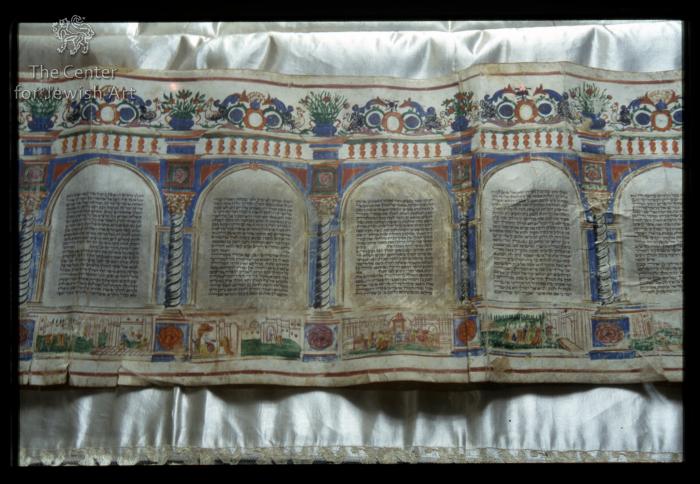Obj. ID: 5203 AEJM Gaster II Type Esther Scroll, Venice (?), second half of the 17th century

This scroll is decorated in the Gaster II style (for the explanation of the name see "Additional Remarks"). These lavishly decorated megillot were produced in a mixture of print and manuscript techniques: the decorative border is partly printed but also features copper engravings and hand-colored illuminations. In this style, the Hebrew text of the Book of Esther is penned by a scribe. The main part of the pattern consists of a series of arcades, under which the text of the Megillah is inscribed. The text panels are interspersed by columns whose bases are decorated with a flower. They separate rectangular frames in which figurative scenes that chronicle the narrative of the Book of Esther are depicted. Upper margins are filled with a balustrade on which are placed flower-filled vases and pairs of roosters and turkeys. The scrolls end with symmetrical decoration composed of foliate and floral ornaments. The general layout of the decoration is the same in all exemplars of the scrolls. However, particular manuscripts differ in detail; their opening decorations especially vary (for a similar opening part see ID 34123).
The decorative scheme of Gaster II scrolls shows common features with the Griselini and Griselini-Related scrolls (see "Griselini scrolls" and "Griselini-Related scrolls" in the Index), whereas the narrative scenes are the same as in the scrolls representing Klagsbald type (see IDs 31, 38212).
For another scroll representing the same type of ornamentation see ID 34123.
The scroll may have been accompanied by a decorated benedictions sheet and a bag (or piece of green fabric).
According to the museum card: "Donated by Mrs. Ada and Prof. Gino Sacerdote of Turin in memory of the grandmother Emilia Leblis of Pugliese, born in Casale 1856 and buried there in the old cemetery in 1932." Donated on February 25th, 1996. ["dono dei Sigg. Ada e Prof. Gino Sacerdote di Torino in memoria della nonna Emilia Leblis in Pugliese nata a Casale 1856 e ivi sepolta nel vecchio cimitero nel 1932. di pertinenza del Museo d' Arte e Storia Antica Ebraica di Casale Monferrato e successivamente passato alla Fondazione Arte, Storia e Cultura Ebraica a Casale Monf.to e nel Piemonte Orientale ONLUS"]
The scrolls representing the same or similar pattern are discussed in:
Mendel Metzger, "The Earliest Engraved Italian Megilloth", Bulletin of the John Rylands Library, 48:2 (1966), 381‒432.
Dagmara Budzioch, The Decorated Esther Scrolls from the Museum of the Jewish Historical Institute in Warsaw and the Tradition of Megillot Esther Decoration in the Seventeenth and Eighteenth Centuries – An Outline [Polish: Dekorowane zwoje Estery z Żydowskiego Instytutu Historycznego w Warszawie na tle tradycji dekorowania megilot Ester w XVII i XVIII wieku. Zarys problematyki], Warsaw 2019, 1:124-134, 322.
The scrolls representing the same or similar pattern are discussed in:
Dagmara Budzioch, The Decorated Megillot Esther in the Moses Gaster Hebrew Manuscript Collection at the John Rylands Library: a comparative analysis with reference to Eighteenth-century Italian scrolls, Journal of Semitic Studies Supplement Series [in print].
Hebrew and Judaic manuscripts in Amsterdam public collections Catalogue of the manuscripts of the Bibliotheca Rosenthaliana, University Library of Amsterdam eds. L. Fuks and R. G. Fuks-Mansfeld, Leiden 1973.



